Apr 05, 2009
Fact? Or Junk Science? Are We Warming? Or Cooling?
By Frank W. Wagner, Virginia’s General Assembly
In its April 28, 1975, issue, 34 years ago, Newsweek magazine published an article titled “The Cooling World.” The article touted the “fact” that global cooling was the next great disaster to be visited upon the world. Data had been collected that indicated a great cooling trend, including shorter growing seasons and smaller crop harvests. This led some scientists to believe the Earth was entering a new ice age, the effects of which would change--or, in the worst case, destroy--human habitation.
Fast-forward to 2005: We are told global warming is the new threat to mankind. Further, we are told that human activity is the cause of this calamity; if we don’t make extreme changes--immediately--to basic human activities, the world as we know it will end. Puzzled? Me, too.
Consider this quote from the aforementioned Newsweek article. “To scientists seemingly disparate incidents represent advance signs of fundamental changes in the world’s weather. The central fact is that after three-quarters of a century of extraordinarily mild conditions, the Earth’s climate seems to be cooling down.” Then comes renowned scientist Al Gore promoting just the opposite viewpoint. The Earth is warming and catastrophe is right around the corner.
I have followed scientists on both sides of the issue, and I am convinced that no one is absolutely sure what is going on climate-wise. Activity on the sun’s surface has more to do with our planet’s climate than does any other variable. And, by the way, data are in that indicate that not only has the global climate not warmed over the past eight years, it has entered another slight cooling period.
TAKING ACTION?
Back to the 1975 article. It stated: “Climatologists are pessimistic that political leaders will take any positive action to compensate for climate change, or even to allay its effects. They concede that some of the more spectacular solutions proposed, such as melting the Arctic ice cap by covering it with black soot or diverting Arctic rivers, might create problems far greater than they solve.” Thank God for the wisdom of those political leaders. Unfortunately, many of today’s political leaders are ready to “cap-and-trade” our economy to other countries and/or apply a carbon tax in an attempt to force America to unilaterally reduce CO2 emissions. There is little doubt that either of these measures will increase the cost of energy in the U.S.
Consider excerpts from a statement by Terry M. Dinan, senior advisor at the Congressional Budget Office, on March 12 before a U.S. House of Representatives subcommittee: “Under a cap-and-trade program, firms would not ultimately bear most of the costs of the allowances but instead pass them along to their customers in the form of higher prices. “Price increases would be essential to the success of a cap-and-trade program because they would be the most important mechanism through which businesses and households would be encouraged to make investments and behavioral changes that reduced CO2 emissions. Those increases, however, would impose a larger burden, relative to their income, on low-income households than on higher-income households.” Regarding how large a new tax would be under cap-and-trade, “CBO estimates that by 2020, the value of those allowances could total between $50 billion and $300 billion annually (in 2006 dollars).” Doing the math, this translates roughly to a new tax of between $142 and $857 annually, for every man, woman, and child in this country.
The report continues: “The higher prices that would result from a cap on CO2 emissions would reduce demand for energy and energy-intensive goods and services, and thus create losses for some current investors and workers in the sectors of the economy that supply such products.” At a time when our economy is on the brink, why would any thinking person in Washington consider legislation that could aggravate a bad situation? As a policymaker who enacts legislation that has real impact on the constituents who elected me, I am not prepared to support that which would weaken an already ailing economy.
WE NEED A PLAN
It is time for us to demand that our leaders in Washington develop a comprehensive and workable national energy plan that includes not just conservation and renewable energy, but an expansion of the nuclear industry and opening up America’s vast natural resources. An energy strategy for the commonwealth was created through the Virginia Energy Plan, which I submitted and which was passed in 2006. We now spend nearly $700 billion per year to purchase fossil fuels from outside of our borders. Currently, there is no policy in Washington to address this bleeding. Imagine that this money is spent in the United States, taking advantage of America’s natural resources, employing American workers to produce American energy for American homeowners and industries.
Pass cap-and-trade legislation and it will never happen. Under cap-and-trade, major global corporations will shutter their American plants, sell their carbon credits for huge dollars (with Wall Street getting more than its fair share), and expand operations in India and other emerging economies where protecting the environment is not on the short list. The results? No reduction in global carbon output, loss of American jobs, and big bucks for Wall Street.
The furor over this crisis du jour is based, at best, on a “theory” of imminent global warming, when actual data suggest the Earth is cooling. Just like in 1975.
Apr 04, 2009
RSS and UAH Global Temperature Anomalies for March 2009
By Anthony Watts, Watts Up With That
The RSS (Remote Sensing Systems of Santa Rosa, CA) Microwave Sounder Unit (MSU) lower troposphere global temperature anomaly data for March 2009 (larger image here) was published today and has dropped for the second month after peaking in January. The change from February with a value of 0.230C to March’s 0.172C is a (∆T) of -0.058C.
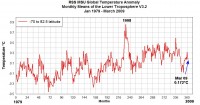
Like RSS, UAH was also announced today, on the blog of Dr. Roy Spencer here who is co-curator of the data with Dr. John Christy at the University of Alabama, Huntsville. See below (larger image here).
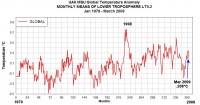
It showed a significant drop, more than double that of RSS. The change from February with a value of 0.347C to March’s 0.208C is a (∆T) of -0.139C. Oddly, a divergence developed in the Feb 09 data between RSS and UAH, and opposite in direction to boot.
I spoke with Dr. Roy Spencer at the ICCC09 conference (3/10) and asked him about the data divergence. Here is what he had to say: “I believe it has to do with the differences in how diurnal variation is tracked and adjusted for.” he said. I noted that Feburary was a month with large diurnal variations. For that reason, UAH has been using data from the AQUA satellite MSU, and RSS to my knowledge does not, and makes an adjustment to account for it. I believe our data [UAH] is probably closer to the true anomaly temperature, and if I’m right, we’ll see the two datasets converge again when the diurnal variations are minimized.” Looks like the data sets are converging now. Read more and see what impact the big spike in 1998 had on the trend here.
See Bob Tisdale’s ocean sea surface temperature anomaly update here. Note the cooling of the Atlantic (AMO) which together with a cold PDO and a sun in slumber should lead to a decline in global temperatures in the months ahead.
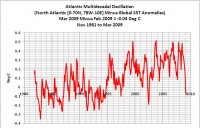
This together with a cold PDO and a sun in slumber should lead to a decline in global temperatures in the months ahead as we saw in the middle 20th century.
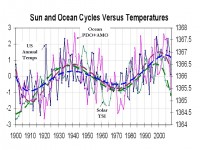
See larger image here.
Apr 03, 2009
Global Warming: A Classic Case of Alarmism
This is a Guest Post by Dr David Evans on Joanne Nova’s site

The big temperature picture. Graph and insight from Dr Syun Akasofu
(2009 International Conference on Climate Change, New York, March 2009).
The global temperature has been rising at a steady trend rate of 0.5C per century since the end of the little ice age in the 1700s (when the Thames River would freeze over every winter). On top of the trend are oscillations that last about thirty years in each direction:
1882 - 1910 Cooling
1910 - 1944 Warming
1944 - 1975 Cooling
1975 - 2001 Warming
In 2009 we are where the green arrow points, with temperature leveling off. The pattern suggests that the world has entered a period of slight cooling until about 2030.
There was a cooling scare in the early 1970s at the end of the last cooling phase. The current global warming alarm is based on the last warming oscillation, from 1975 to 2001. The IPCC predictions simply extrapolated the last warming as if it would last forever, a textbook case of alarmism. However the last warming period ended after the usual thirty years or so, and the global temperature is now definitely tracking below the IPCC predictions.
The IPCC blames human emissions of carbon dioxide for the last warming. But by general consensus human emissions of carbon dioxide have only been large enough to be significant since 1940 - yet the warming trend was in place for well over a century before that. And there was a cooling period from 1940 to 1975, despite human emissions of carbon dioxide. And there has been no warming since 2001, despite record human emissions of carbon dioxide.
There is no actual evidence that carbon dioxide emissions are causing global warming. Note that computer models are just concatenations of calculations you could do on a hand-held calculator, so they are theoretical and cannot be part of any evidence. Although the models contain some well-established science, they also contain a myriad of implicit and explicit assumptions, guesses, and gross approximations—mistakes in any of which can invalidate the model outputs. The pattern suggests that the world has entered a period of slight cooling until about 2030
Furthermore, the missing hotspot in the atmospheric warming pattern observed during the last warming period proves that (1) the IPCC climate theory is fundamentally broken, and (2) to the extent that their theory correctly predicts the warming signature of increased carbon dioxide, we know that carbon dioxide definitely did not cause the recent warming (see here for my full explanation of the missing signature. The alarmists keep very quiet about the missing hotspot.
No one knows for sure what caused the little ice age or for how many more centuries the slow warming trend will continue. It has been warmer than the present for much of the 10 thousand years since the last big ice age: it was a little warmer for a few centuries in the medieval warm period around 1100 (when Greenland was settled for grazing) and also during the Roman-Climate Optimum at the time of the Roman Empire (when grapes grew in Scotland), and at least 1°C warmer for much of the Holocene Climate Optimum (4 to 8 thousand years ago).
Addendum
Measuring the global temperature is only reliably done by satellites, which circle the world 24/7 measuring the temperature over large swathes of land and ocean. But satellite temperature records only go back to 1979. Before that, the further back you go the more unreliable the temperature record gets. We have decent land thermometer records back to 1880, and some thermometer records back to the middle of the 1700s. Prior to that we rely on temperature proxies, such as ice cores, tree rings, ocean sediments, or snow lines. Read post here. The powerpoint and audio from Dr Akasofu’s presentation at The International Climate Change Conference 2009 can be downloaded here.
Apr 01, 2009
The Thune Amendment and the Johanns Amendment Vote Down Climate Tax Bill
By Roger Pielke, Jr., Prometheus
The ability of Congressional legislation on cap and trade that results in actual emissions reductions died an early death last night. An Amendment was introduced by Senator John Thune (R-SD) on the Budget Resolution and its text is as follows:
To amend the deficit-neutral reserve fund for climate change legislation to require that such legislation does not increase electricity or gasoline prices.
What is this? Climate change legislation cannot increase electricity or gasoline prices? The entire purpose of cap and trade is in fact to increase the costs of carbon-emitting sources of energy, which dominate US energy consumption. The Thune Amendment thus undercuts the entire purpose of cap and trade.
What was the vote on the Thune Amendment? 89-8 in favor of the Amendment, 48 Democrats and 41 republicans. Only 8 members of the Senate were willing to go on record saying that they support the purpose of a cap and trade bill, to make carbon-emitting energy more expensive. Barbara Boxer (D-CA) voted for the Thune Amendment had this to say:
Any kind of cap-and-trade system that comes forward will not raise energy and gas prices.
The Thune Amendment effectively kills cap and trade as a mechanism for reducing emissions. I have little doubt that the legislation will go forward, and it likely will pass in some form and do many things. Its just that reducing emissions won’t be among them. Cap and trade is dead, but the charade will go on.
For those who may be wondering, this post is not an April Fools Joke. See post and comments here.
Also in congress in this EPW release, the Johanns amendment to prohibit the use of budget reconciliation for cap-and-trade legislation, passed by 67-31 in a bipartisan vote. As Senator Inhofe said “Reconciliation was designed for deficit reduction, not major policy initiatives like climate change, which should be fully debated through regular order in the Committees of jurisdiction. Further, use of such procedures for climate legislation rejects the twin goals of transparency and bipartisanship so often mentioned by the Administration.”
“I appreciate the leadership of Senator Johanns and Byrd on this important issue. Opposition to this tactic came from both sides of the aisle, both sides of the Capitol, and all sides of the climate debate itself, including those who have co-sponsored or otherwise supported cap-and-trade.”
Apr 01, 2009
Deep Solar Minimum
NASA Earth Observatory
April 1, 2009: The sunspot cycle is behaving a little like the stock market. Just when you think it has hit bottom, it goes even lower.
2008 was a bear. There were no sunspots observed on 266 of the year’s 366 days (73%). To find a year with more blank suns, you have to go all the way back to 1913, which had 311 spotless days: plot. Prompted by these numbers, some observers suggested that the solar cycle had hit bottom in 2008. Maybe not. Sunspot counts for 2009 have dropped even lower. As of March 31st, there were no sunspots on 78 of the year’s 90 days (87%). It adds up to one inescapable conclusion: “We’re experiencing a very deep solar minimum,” says solar physicist Dean Pesnell of the Goddard Space Flight Center.
“This is the quietest sun we’ve seen in almost a century,” agrees sunspot expert David Hathaway of the Marshall Space Flight Center.

Above: The sunspot cycle from 1995 to the present. The jagged curve traces actual sunspot counts. Smooth curves are fits to the data and one forecaster’s predictions of future activity. Credit: David Hathaway, NASA/MSFC.
Quiet suns come along every 11 years or so. It’s a natural part of the sunspot cycle, discovered by German astronomer Heinrich Schwabe in the mid-1800s. Sunspots are planet-sized islands of magnetism on the surface of the sun; they are sources of solar flares, coronal mass ejections and intense UV radiation. Plotting sunspot counts, Schwabe saw that peaks of solar activity were always followed by valleys of relative calm - a clockwork pattern that has held true for more than 200 years: plot.
The current solar minimum is part of that pattern. In fact, it’s right on time. “We’re due for a bit of quiet- and here it is,” says Pesnell. But is it supposed to be this quiet? In 2008, the sun set the following records:
A 50-year low in solar wind pressure: Measurements by the Ulysses spacecraft reveal a 20% drop in solar wind pressure since the mid-1990s - the lowest point since such measurements began in the 1960s. The solar wind helps keep galactic cosmic rays out of the inner solar system. With the solar wind flagging, more cosmic rays are permitted to enter, resulting in increased health hazards for astronauts. Weaker solar wind also means fewer geomagnetic storms and auroras on Earth.
A 12-year low in solar “irradiance”: Careful measurements by several NASA spacecraft show that the sun’s brightness has dropped by 0.02% at visible wavelengths and a whopping 6% at extreme UV wavelengths since the solar minimum of 1996. These changes are not enough to reverse the course of global warming, but there are some other, noticeable side-effects: Earth’s upper atmosphere is heated less by the sun and it is therefore less “puffed up.” Satellites in low Earth orbit experience less atmospheric drag, extending their operational lifetimes. That’s the good news. Unfortunately, space junk also remains longer in Earth orbit, increasing hazards to spacecraft and satellites.
A 55-year low in solar radio emissions: After World War II, astronomers began keeping records of the sun’s brightness at radio wavelengths. Records of 10.7 cm flux extend back all the way to the early 1950s. Radio telescopes are now recording the dimmest “radio sun” since 1955: plot. Some researchers believe that the lessening of radio emissions is an indication of weakness in the sun’s global magnetic field. No one is certain, however, because the source of these long-monitored radio emissions is not fully understood.
All these lows have sparked a debate about whether the ongoing minimum is “weird”, “extreme” or just an overdue “market correction” following a string of unusually intense solar maxima. “Since the Space Age began in the 1950s, solar activity has been generally high,” notes Hathaway. “Five of the ten most intense solar cycles on record have occurred in the last 50 years. We’re just not used to this kind of deep calm.” Deep calm was fairly common a hundred years ago. The solar minima of 1901 and 1913, for instance, were even longer than the one we’re experiencing now. To match those minima in terms of depth and longevity, the current minimum will have to last at least another year.
In a way, the calm is exciting, says Pesnell. “For the first time in history, we’re getting to see what a deep solar minimum is really like.” A fleet of spacecraft including the Solar and Heliospheric Observatory (SOHO), the twin STEREO probes, the five THEMIS probes, ACE, Wind, TRACE, AIM, TIMED, Geotail and others are studying the sun and its effects on Earth 24/7 using technology that didn’t exist 100 years ago. Their measurements of solar wind, cosmic rays, irradiance and magnetic fields show that solar minimum is much more interesting and profound than anyone expected.
Modern technology cannot, however, predict what comes next. Competing models by dozens of top solar physicists disagree, sometimes sharply, on when this solar minimum will end and how big the next solar maximum will be. Pesnell has surveyed the scientific literature and prepared a “piano plot” showing the range of predictions. The great uncertainty stems from one simple fact: No one fully understands the underlying physics of the sunspot cycle. Pesnell believes sunspot counts will pick up again soon, “possibly by the end of the year,” to be followed by a solar maximum of below-average intensity in 2012 or 2013. But like other forecasters, he knows he could be wrong. Bull or bear? Stay tuned for updates. Read more here.
Still some level of uncomfortable denial on the part of Hathaway who in late 2006 had proclaimed solar minimum and that solar cycle 24 was underway. It is at the very least like the cycles of the early 1900s but may be more like the early 1800s, the Dalton Minimum. As they said, time will tell.
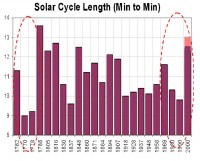
See also this paper in Energy and the Environment by Oliver Manuel.
|









